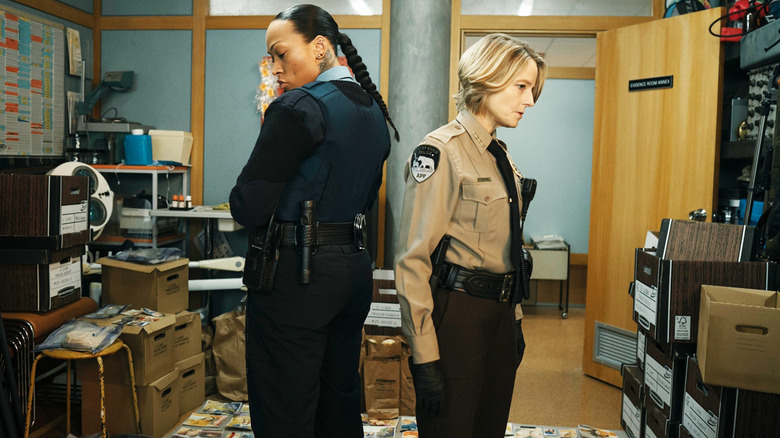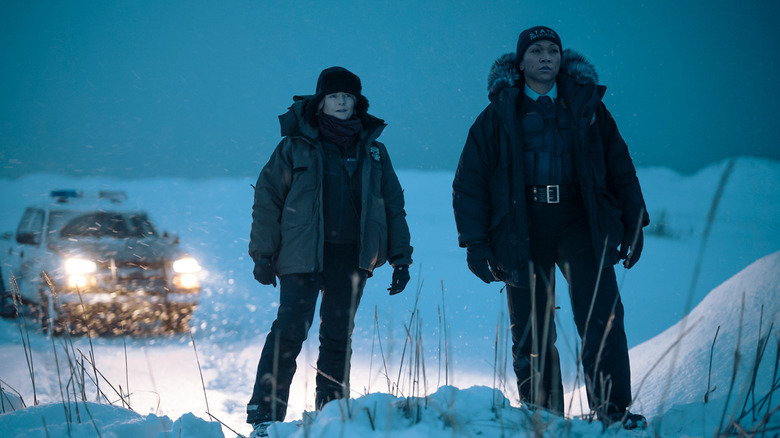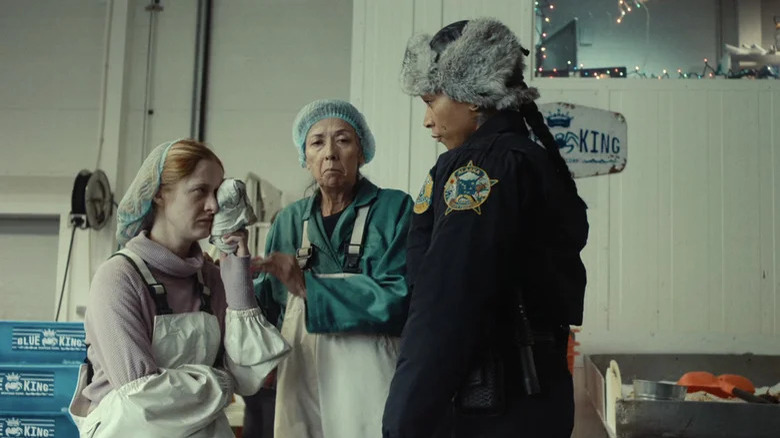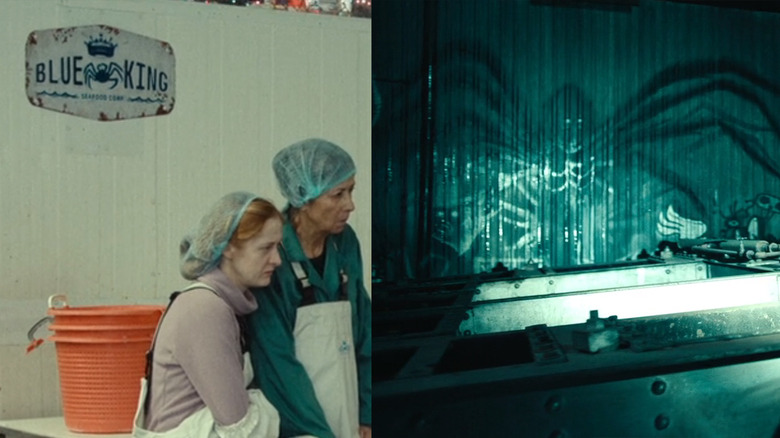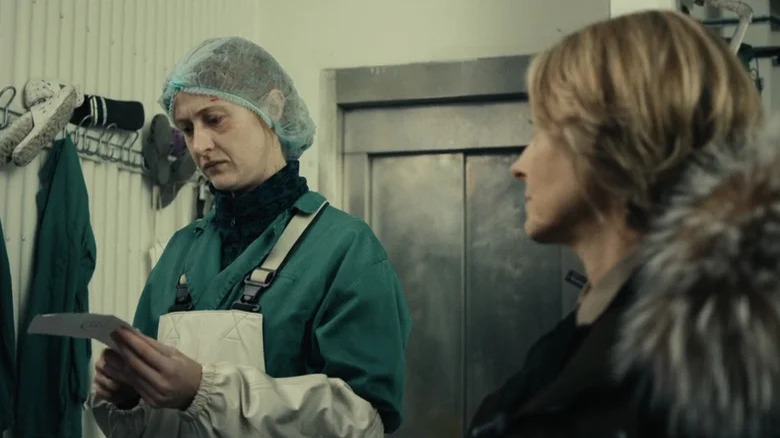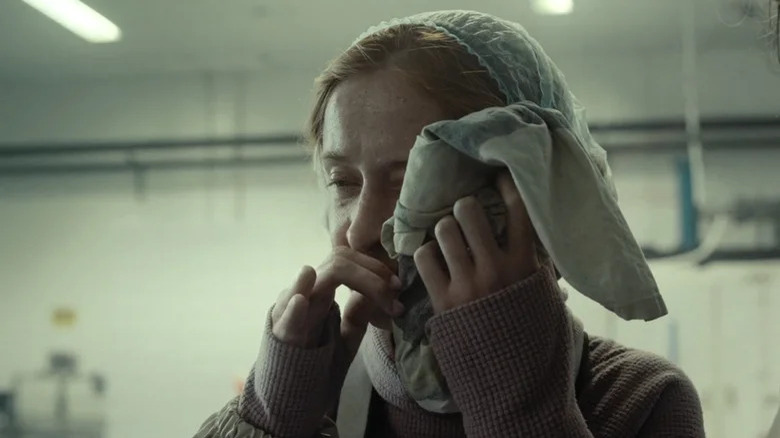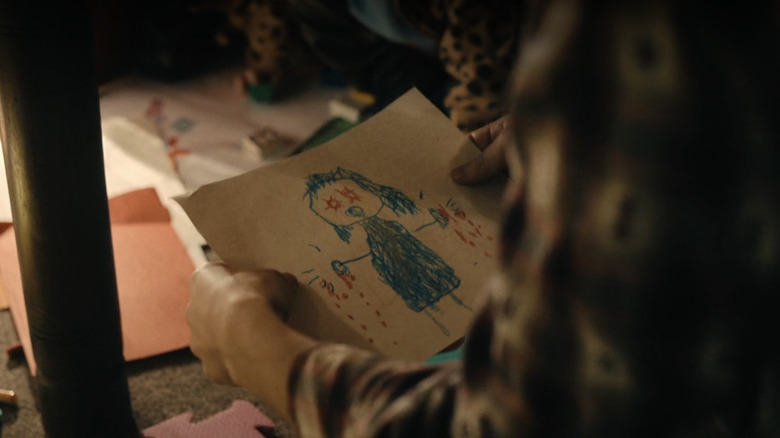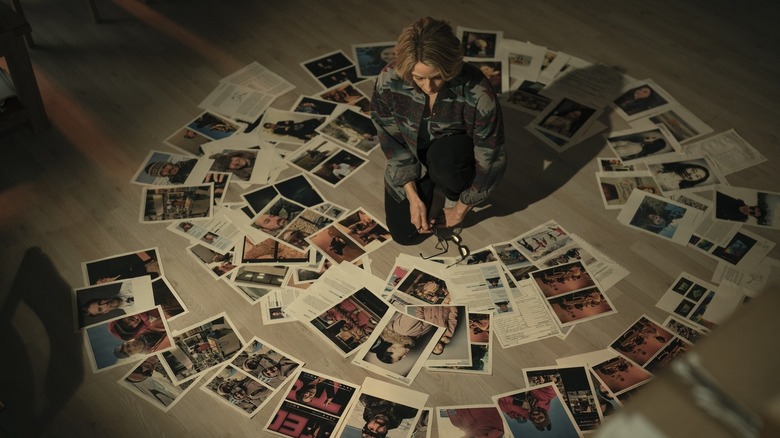Every Clue To Solving The Mystery Of True Detective: Night Country You Missed This Season
This post contains major spoilers for "True Detective: Night Country"
"True Detective: Night Country" has drawn to a close and it turns out there are no Lovecraftian beasts or evil spirits from the beyond to blame for the goings on in Ennis, Alaska. Instead, we learned the Tsalal research station scientists perished at the hands of an enraged mob made up of Ennis' embattled women. Or, rather, as a result of being stripped naked and forced onto the Alaskan tundra by said mob.
Of course, there's a lot more to the "Night Country" finale than that. Far from just being a bunch of peeved-off cleaners, the ladies of Ennis become the physical embodiment of an ancient Inuit legend, awakened by the horrific injustices visited upon her land. Throughout "Night Country," we see the women of Ennis fall victim to domestic violence, stillbirths as a result of the polluted environment, and in the case of Annie Kowtok (Nivi Pedersen), actual murder. So, by the time we witness the death of the scientists, the ladies have had just about enough of it all.
For many, this will be a satisfying conclusion to a show that strongly hinted at some supernatural explanation for the mystery of the scientists' deaths. Others might feel let down that showrunner Issa López never followed through on finally fulfilling the cosmic horror promises of "True Detective" season 1. But whatever you think of the finale, you'll surely be replaying the season in your head trying to figure out how all the pieces fit together and what clues you missed along the way. Whether you saw them or not, those clues were there, and I've gone and collated them all here for your convenience.
What happened in the Night Country season finale?
After a terrifying conspiracy surfaced in episode 5, the "Night Country" finale revealed that the Tsalal scientists killed Annie K. Why? Annie was in a relationship with one of the researchers — Raymond Clark (Owen McDonnell) — and discovered her beau and his cohorts had a secret ice cave below the Tsalal facility. After sneaking into this cave, Annie found that the scientists were not only covering up dangerous levels of pollution emitted by the nearby Silver Sky mine, but actually encouraging the mine to produce more pollutants. The way Clark explains it in the finale, these pollutants softened the permafrost which he and his colleagues were excavating, making it easier to extract a rare micro-organism that could potentially solve humanity's biggest challenges.
Annie wasn't too thrilled about more pollution in a town already ravaged by stillbirths, polluted water, and the general degradation wrought by Silver Sky contaminating the entire area. So, she destroyed the ice cave lab, wiping out much of the scientist's progress. When the men discovered this, they flew into a rage and killed the poor woman, with Raymond Clark finishing the job despite his protestations to Liz Danvers and Evangeline Navarro that he "loved" her. Sadly for the scientists, the Tsalal cleaning ladies found out what happened during one of their scheduled cleans, and along with an assortment of similarly beleaguered female Ennis residents, became vengeance incarnate, laying siege to the Tsalal station and sending the researchers out into the frozen night to perish. Naked.
But what about all those visions of the dead and the strong suggestion that something truly supernatural was afoot? Well, if you take a look back through the season, you'll see that there was plenty of foreshadowing that hinted at this big, non-supernatural reveal.
The clues were there from episode 1
In episode 5 of "Night Country," a small but significant moment hinted at the culprits behind the scientists' deaths. That moment came when Evangeline Navarro met Eddie Qavvik (Joel D. Montgrand) at the laundromat owned by Kayla Malee (Anna Lambe)'s grandmother. Eddie brought his friend Kenny (David Shackelford) who explained that the spiral symbol seen throughout the preceding episodes was a warning to stay off thin areas of ice. As he's speaking, Blair Hartman (Kathryn Wilder), a former Tsalal cleaner and current employee of the Blue King crab processing plant, enters and begins doing laundry. Blair's brief appearance here might have seemed like nothing, but to those who'd spotted some earlier clues, it was significant.
We first met Blair in episode 1, when Navarro was called to the Blue King plant to respond to an assault report. There, Blair was introduced alongside Bee (Diana E. Benson), a fellow former Tsalal cleaner and Blue King employee who turns out to be somewhat of a ringleader in the finale. In her first appearance, Bee is introduced as somewhat of a custodian of the women of Ennis, foreshadowing her eventual reveal as the leader of the women's siege of Tsalal. When Navarro arrives at the Blue King plant, she discovers that Blair's ex-boyfriend, Ace (Aron Már Ólafsson), was abusive, and tried to hurt Blair while she was working, only for Bee to knock him out with a bucket.
But establishing Bee as a protector wasn't the only important element of this scene. In fact, if you were paying close attention, you might have noticed some pretty overt clues as to who was responsible for the scientists' deaths.
The Blue King clue
One of the most intriguing elements of the scene introducing Blair and Bee is the Blue King branding itself. Back in season 1, Matthew McConaughey's Rustin Cohle and Woody Harrelson's Marty Hart were on the case of a child abuse cult obsessed with something known as the Yellow King. There are multiple interpretations of what the Yellow King actually was, suffice it to say that the image, borrowed from Robert Chambers' 1895 short story collection "The King in Yellow," was yet another example of cosmic horror symbolism in "True Detective."
As such, the Blue King branding seemed significant when we first saw it in "Night Country," especially since, as many Redditors noted, the sign for the factory would appear at various points suggestively flanking both Blair and Bee. But why is it blue instead of yellow? Well, Issa López has used "Night Country" to reinterpret many of the symbols introduced in the inaugural season, most obviously the spiral motif. Here, the Blue King logo seemingly hinted that the culprits were right in front of us, but rather than being the malevolent force represented by the Yellow King, these Blue alternatives represent a vengeful force that seeks to restore justice to a land blighted by inequity and oppression — more on that later.
Interestingly enough, the crab on the Blue King logo actually bears a resemblance to the graffiti seen on the walls of the abandoned dredge in episode 4. While exploring the dilapidated machine, Liz Danvers walks past graffiti depicting a monster with multiple legs that looks oddly similar to Cthulhu from the H.P. Lovecraft mythos. But it also resembles the crab from the Blue King logo, perhaps representing yet another hint that the women of the Blue King processing plant were behind the scientists' demise.
Blair sees the spiral for the first time
After we first meet Blair and Bee at the Blue King plant, episode 2 shows Liz Danvers visiting the pair at work. This time, Chief Danvers brings a sketch of the spiral symbol, which was found drawn on the forehead of Anders Lund (Þorsteinn Bachmann) — the scientist who in a callback to a classic David Fincher moment, came to life after seemingly having frozen to death alongside his colleagues. Danvers shows the symbol to Bee, who says, "What is that a cult sign? Witchcraft?"
Of course, back in season 1, the spiral was tied directly to the cult responsible for several murders and for running a child abuse ring in Southern Louisiana. Here, however, we now know that Bee was the one who drew the spiral on Lund's forehead, so she absolutely knew what it meant when Danvers showed her the sketch.
After Bee denies having seen the spiral motif, she asks Blair, "You ever see anything like that devil sign?" Blair says "No" but looks visibly shaken after seeing the sketch and leaves frame quickly. Knowing what we know now, this was a major clue early on in the season, suggesting Blair at least knew more than she was letting on, and perhaps had some inside knowledge of how the scientists perished.
The missing fingers
Returning to the scene from episode 1 where we first meet Blair and Bee, it turns out this introduction was even more significant than we thought. During Evangeline Navarro's visit to the Blue King plant, Blair sits with her right hand tucked under her left elbow. But in a brief close-up shot, she uses her right hand to wipe her face, revealing a missing ring finger and pinky.
In episode 2, after the discovery of the horrific "corpsicle" containing the Tsalal scientists' bodies, Prior meets Danvers at the ice rink and tells her that police recovered a handprint from the Tsalal crime scene. We then get a glimpse of the print in question, which appears to be missing the same fingers as Blair. In the season finale, we get confirmation via flashback that this print did indeed belong to Blair, who during the siege was desperately trying to pry open the hatch to the secret ice cave below the research station, in which Raymond Clark was hiding.
Of course! It all makes sense now. But Blair's missing fingers were, admittedly, easy to miss in that quick closeup from episode 1. As such, Issa López made sure to give us even more by way of missing digit clues. In the first episode of "Night Country," officer Peter Prior (Finn Bennett) returns home to find that his infant son, Darwin, has drawn a monstrous female figure with her fingers severed and blood dripping from her hands. Prior's wife, Kayla, tells him the drawing is of a "local legend" but provides no further information. Thankfully López herself confirmed that this drawing represents a real Inuit legend, which for those paying close attention, provided yet more clues as to how the scientists met their fate.
The Sedna legend
Issa López, who's proven herself to be the perfect fit for "True Detective," shed some light on Prior's son's unsettling sketch when she responded to an Instagram question about whether "Darwin's drawing is Sedna/Nuliajuk?" with, "ah! Good eye!" This confirms the drawing was in fact a representation of the Inuit legend of Sedna the sea goddess.
As the creation myth goes, Sedna, a young woman from the Arctic, married an Inuk and went to live with her new husband on his island, where he eventually revealed himself to be a bird spirit dressed as a man. After visiting his daughter on the island, Sedna's father killed her husband for lying and fled with Sedna in his kayak. Unfortunately, the bird-man's friends (or in some versions the spirit of the slain birdman himself) tracked the pair down and swarmed their boat, during which time Sedna's father threw his daughter overboard to prevent the craft from sinking. According to the legend, the young girl clung to the side of the boat before her father cut off her fingers. Those severed digits then became various sea creatures while Sedna sank to the ocean floor, becoming a powerful spirit with the head and torso of a woman and the tail of a fish.
So there you have it. A woman who faced innumerable injustices becoming a powerful, elemental force. Sounds a lot like what happens in "Night Country," right? In that sense, Darwin's Sedna drawing can be seen as an early hint that the former cleaners and Blair, with her missing fingers, were involved in the scientists' deaths.
'They woke her up'
As is customary with this crime anthology series, "True Detective: Night Country" gave rise to multiple theories about what happened to the scientists. But Issa López, who wrote and directed the entire season with the help of some co-writers on specific episodes, provided several clues as to the right explanation throughout. She made sure to repeatedly show us the results of Silver Sky Mining and the Tsalal facility's conspiracy. The stillbirths, the black water, the death of Annie K who opposed the presence of the mine. It was all designed to justify the actions of the women, who decided to "tell themselves a different story, with a different ending" as Bee puts it in the finale. This "different story" saw the women organizing and taking justice into their own hands, becoming the spirit of a Sedna-like entity in the process by wreaking vengeance on the men who not only killed Annie Kowtok, but who degraded the natural environment by encouraging the mine's pollution.
You might have heard several characters repeating the phrase "She's awake" throughout the show. Now, with what we know about what transpired with the scientists, these words can be interpreted as yet another clue referring to Sedna, or at least some sort of nebulous spirit awakened by the wrongdoings of the mine and the Tsalal men. As Bee says during the finale, "They did it to themselves, when they dug in her home in the ice, when they killed her daughter in there. They woke her up." Here, "her" refers to Sedna, and the spiral Bee drew on Lund's forehead is a representation of her vengeful spirit. The women of Ennis saw themselves as carrying out Sedna's will, and were simply vessels through which the sea goddess could enact justice.
